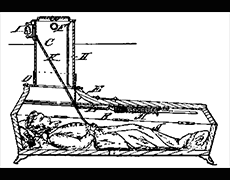
Vester’s safety coffins, also known as “security coffins,” were designed by Franz Vester in the late 19th century.
These coffins aimed to prevent premature burial by incorporating various mechanisms to allow the occupant to signal for help if they were mistakenly buried alive.
Some designs included features like bells attached to the coffin lid, ventilation pipes, and even escape hatches.
While these safety measures offered peace of mind to some, the effectiveness of Vester’s safety coffins in preventing premature burial is questionable, and they were eventually replaced by more reliable methods of determining death.
Below is an article, published in 1879, about Vester testing out one of his safety coffins.
An Extraordinary Exhibition

A German gentleman, named Vester, a resident of Newark, once obtained a patent for a safety coffin, designed to provide a way of escape to those who might be buried during suspension of animation.
This invention consists of a coffin constructed similar to those now in use, except that it is a little higher to allow of the free movement of the body; the top lid is movable from head to breast, and in case of interment is left open, with a string attached for closing the same.
Under the head is a receptacle for refreshments and restoratives.
The important part of the invention is a box two feet square, resembling very much a chimney, with a cover and ornamental grave work on the top.
The box is of sufficient length to extend from the head of the coffin to about one foot above the ground. The cover is fastened down with a catch and cannot be unfastened from the outside. Just below the cover is a bell with a cord appended, which upon being pulled, sounds an alarm, and at the same time throws the cover from the “chimney box.”

Then, if the person on the inside have sufficient strength, he or she can take hold of a rope suspended from near the top of the chimney, and with the assistance of cleats, ascend to the outer world; or otherwise the individual can ring the bell for the sexton to come and assist him out.
Mr. Vester gave an exhibition of the working of this invention, by being buried, and after more than an hour’s interment, resurrecting himself.
The grave diggers having excavated a hole six feet deep, a black coffin, with silver trimmings, was placed upon two supports over it.
Mr. Vester came forward and took his position in the coffin, the lid of which was placed over him, at which time he was greeted with many an anxious and jocular “good-bye.”
The coffin was lowered to the bottom of the grave.
The “chimney box” was then set down over the coffin, over which some wreaths of flowers had been strewn.
The grave diggers set to work with a will, and, in 15 minutes, with four feet of earth between him and daylight.
After an elapse of an hour and a quarter, a gentleman stated that Mr. Vester was to remain down below for two hours; but that some of the spectators were anxious to return home, and consequently, if agreeable, Mr. Vester would appear at once, or remain the specified time.
All present being satisfied, a signal was given, and a minute after, Mr. Vester, unaided, stepped out of his grace with no more perceptible exhaustion than would have been caused by walking two or three blocks under the hot sun.
His exit was received with enthusiasm and applause, and hundreds rushed to congratulate Mr. Vester upon the success of his novel invention.
Source: St. Landry democrat. (Opelousas, La.), 05 April 1879.

